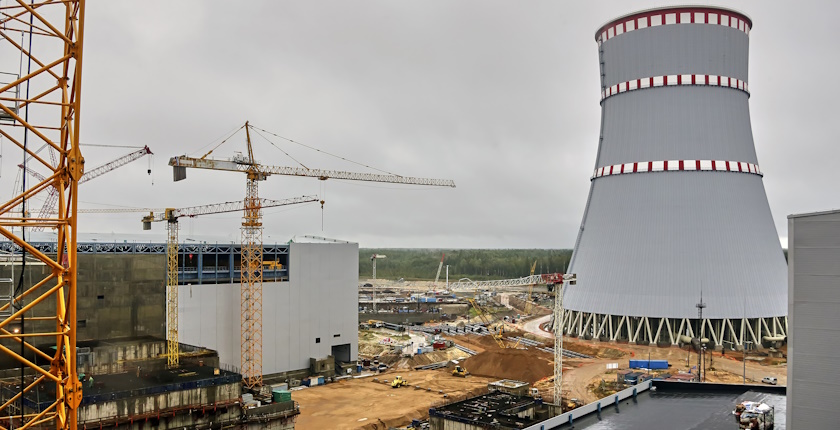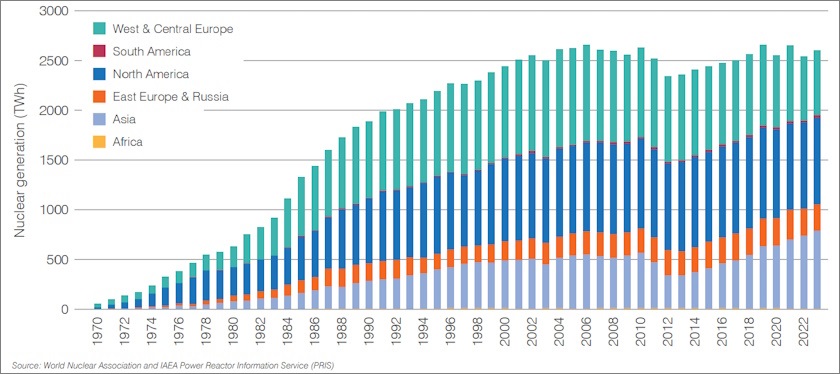
Photo: iStock
Share
Nuclear technologies will have a broader role than traditional grid electricity supply, the World Nuclear Association’s Director General Sama Bilbao y León said upon the release of its World Nuclear Performance Report 2024. Rising demand is expected from end users such as data centers, electric vehicles, chip production, battery manufacturing, desalination and other high-tech sectors, together with conventional industry. Nuclear plant operators see opportunities in direct contracting and overall decarbonization efforts.
According to the World Nuclear Performance Report 2024, nuclear reactors generated 2.6 PWh in 2023 or 2.3% more than one year before. The segment provides 9% of the world’s electricity, second only to hydropower among clean energy sources, the World Nuclear Association said in its annual update.
Reactors that produced electricity last year had a combined capacity of 368 GW, up by 3 GW on 2022. There was 392 GW in operable capacity overall, which includes units in Japan, India and Ukraine that suspended operations.
Reactor performance remains high regardless of age
In gross terms, France accounted for more than two thirds of the global output growth, as it recovered half of the drop caused by extended outages in 2022. This summer’s Olympics host was powered by over 60% nuclear electricity, on average, the report reveals.
Another boost came from the rise in the average capacity factor of 1.1 percentage points year over year, to 81.5%. Reactor performance remains high regardless of age, the association pointed out.
The overall number of operable nuclear reactors in the world remained at 437. Five came online, of which Mochovce 3 in Slovakia is the only one in the European Union. Out of the five that were permanently shut down are Germany’s last three reactors, one in Belgium and one in Taiwan.
Increasing interest from end energy users
Nuclear technologies will have a broader role than traditional grid electricity supply, the World Nuclear Association’s Director General Sama Bilbao y León asserted.
“There is increasing interest from end energy users such as data centers, which have high electricity requirements, and other industrial users that require heat for chemical and material production applications or desalination. This offers the potential to decarbonize the wider economy, especially hard-to-abate sectors,” she explained.
Cement and iron and steel production are among the most difficult ones to decarbonize.
Annual nuclear electricity production is equivalent to 2.1 billion tons of carbon dioxide emissions from coal power
Other high-tech sectors seen lifting demand include electric vehicles, chip production and battery manufacturing.

More countries expected to sign nuclear declaration
Annual nuclear electricity production is equivalent to 2.1 billion tons of carbon dioxide emissions, when compared to coal plants, Bilbao y León pointed out. China, the United States and India are the only countries emitting more of the greenhouse gas every year, she noted.
The association’s chief recalled that 25 governments supported an initiative, launched at the COP28 summit in Dubai, to triple global nuclear capacity. Collaboration and competition in the industry will deliver many new projects over the coming years, in her view.
Al Hammadi: Nuclear energy is a proven, reliable and substantial generator of clean electricity
“The industry is set for a major expansion, and we can expect more governments and companies to sign,” Bilbao y León said. The ever-growing policy support for nuclear, noted in the previous report, has increased further, for both small and large plants with a range of applications, she stressed. Bilbao y León highlighted the resurgence evident in the United States, Canada and Europe.
Nuclear energy is a proven, reliable and substantial generator of clean electricity for 36 countries, according to Managing Director of Emirates Nuclear Energy Corporation (ENEC) and Chair of the World Nuclear Association Mohamed Al Hammadi.
Developers, consumers and decision makers count on technology improvements in the sector, including advanced and small modular reactors – AMRs and SMRs, respectively – for new business models. The ambition is to scale power purchase agreements, balancing and district heating and cooling.
Balkan countries following global nuclear trend
In the region that Balkan Green Energy News tracks, there are active reactors in Slovenia (operated with neighboring Croatia), Romania and Bulgaria, while Turkey is about to commission its first facility. All are preparing more projects including some for SMRs.
Following a memorandum of cooperation on nuclear energy between French state-owned energy company EDF and Serbia, late last month the two sides signed a follow-up letter of engagement to assess the potential for developing a civil nuclear program in Serbia. Also in August, the government adopted a bill that would abolish a moratorium on the construction of nuclear power plants.
Serbia is considering both small and large reactors
Earlier this year, President of Serbia Aleksandar Vučić said electricity consumption is expected to quadruple by 2050. In his view, the only solution to close the gap is to build large and small nuclear plants.
The Slovenian Krško plant (NEK or, in Slovenia, JEK), with one reactor, launched operations in 1983. It is a joint venture with neighboring Croatia. Both were part of the Yugoslav federation at the time. Net capacity is 688 MW.
The country is preparing a referendum on building another nuclear plant. The plan is to hold it in November.
Slovenia said it was in discussions with the US and the United Kingdom on SMR projects, and so did North Macedonia and Turkey.
Most developed SMR project in Southeastern Europe is underway in Romania
The Romanian Cernavodă facility consists of two reactors, completed in 1996 and 2007. The country started the construction of units 3-5 in the 1980s as well, but two were suspended and the remaining one was canceled. Combined, units 1 and 2 operate at a maximum of 1.3 GW. Cernavodă-1 is planned for refurbishment, to extend its operation until 2060.
Both Romania and Bulgaria are expecting to sign engineering contracts in October for two more conventional reactors each
Minister of Energy Sebastian Burduja has said that the government would negotiate with a consortium of two companies from the United States, one from Italy and one from Canada. He expected that the contract for units 3 and 4 would be signed by October, aiming to get them online by 2031 and 2032, respectively.
In addition, Romania is working on the deployment of a small modular reactor (SMR) at the former coal-fired power plant in Doiceşti. It is the most advanced project of the kind in the region and beyond.
Hyundai E&C, Westinghouse Electric picked for two more reactors in Kozloduy
The first unit of the Kozloduy nuclear power plant in northeastern Bulgaria launched operations in 1974. The first two reactors were shut down in 2004 and the second two in 2007. Units 5 and 6 are the strongest in the region, at 1 GW each.
Bulgaria recently canceled the Belene nuclear plant project, opting for two new reactors in Kozloduy. Acting Minister of Energy Vladimir Malinov said last week that the contract with Hyundai Engineering and Construction (Hyundai E&C), based in South Korea, and Westinghouse Electric Co. from the US is expected to be signed in October.
American engineering and construction company Fluor and its subsidiary NuScale, which are working on the SMR project in Romania, agreed three years ago to cooperate with Bulgaria on deploying the technology in Kozloduy. But there was little word about it since.
First unit at Akkuyu in Turkey set to come online next year
Rosatom started the construction of the Akkuyu nuclear plant in Turkey in 2018 through a subsidiary. Under the bilateral agreement, the Russian company will also own and operate the facility. Four reactors of 1.11 GW are due to be put into operation starting next year and until 2028.
The government has revealed that it held talks with Russia, China and South Korea for its second nuclear plant, in Sinop in the country’s northernmost tip, and a third one, in Eastern Thrace, also known as European Turkey.









Be the first one to comment on this article.